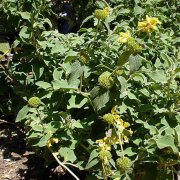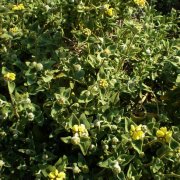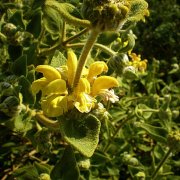Care of the shrub Phlomis lycia or Jerusalem Sage |
|
The genus Phlomis, family Lamiaceae, comprises 100 species of shrubs and herbaceous plants native to Asia and the Mediterranean region. Some species are: Phlomis lycia, Phlomis lanata, Phlomis fruticosa, Phlomis cypria, Phlomis chrysophylla, Phlomis purpurea, Phlomis italica, Phlomis russeliana, Phlomis samia, Phlomis lychnitis, Phlomis maroccana, Phlomis viscosa. Common name: Jerusalem Sage. This species is native to Turkey. They are highly branched evergreen shrubs that reach 1 meter (3.28 feet) in height. The interesting foliage turns golden-gray in spring, yellowish-green in summer, and greyish-green in winter. They have two types of hairy leaves: some oblong-lanceolate and others elongated that appear on the floriferous stems. The showy yellow flowers appear at the nodes of the stems and bloom in spring. Jerusalem Sage is used in rockeries, in hedges and bushes, in Mediterranean gardens by the sea and in dry and poor areas of the garden. Phlomis lycia needs full sun exposure and a Mediterranean climate. It resists frosts down to -8 ºC (17.6 ºF). Jerusalem Sage can grow in sandy, calcareous, rocky and poor soils; excellent drainage is important. Planting is done in spring at the rate of 3 plants per square meter. Phlomis lycia hardly needs watering so it will only be watered sporadically in summer if it's very hot. Jerusalem Sage does not need fertilizers. Prune lightly in late winter to keep it compact. Phlomis lycia is a plant very resistant to pests but sensitive to excess humidity. Jerusalem Sage is propagated from seeds sown in spring. |
Images of the shrub Phlomis lycia or Jerusalem Sage |
Find plants
Phlomis lycia or Jerusalem Sage | Care and Growing
© 2025 FavThemes



